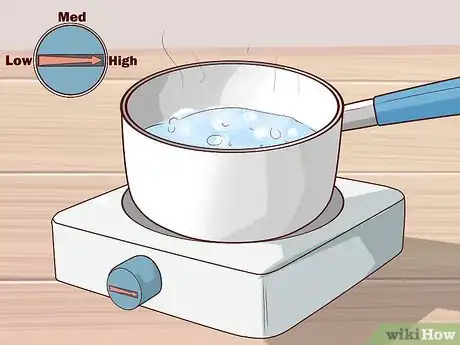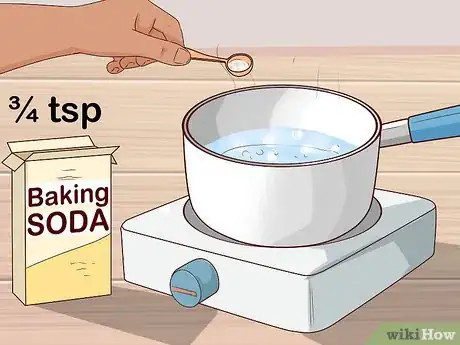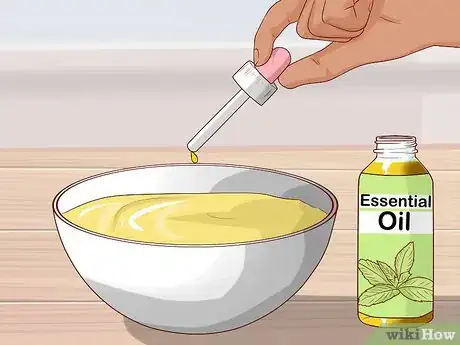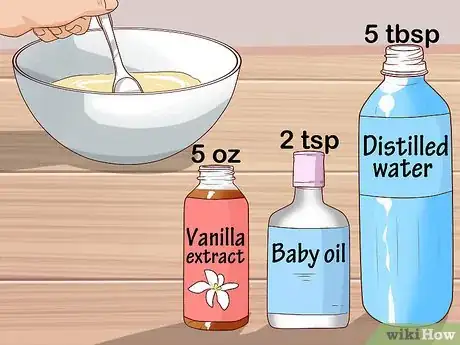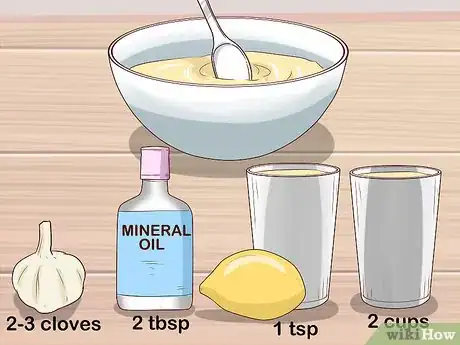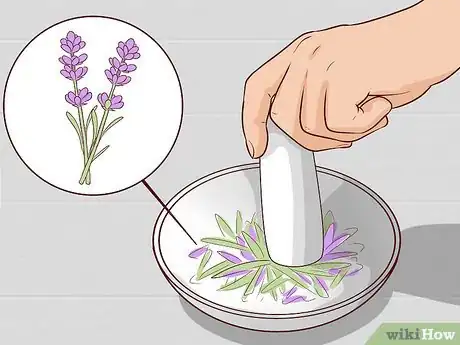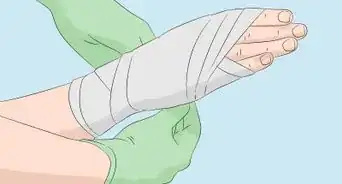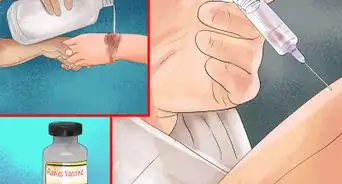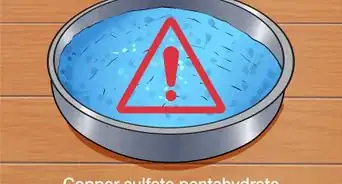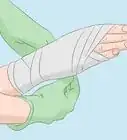This article was co-authored by Joshua Bloom. Joshua Bloom is a Pest Control Specialist and the Vice President of Operations of Standard Pest Management, a pest control company based in New York City. He has over 20 years of experience in the pest control industry and specializes in commercial and large facility pest control management. Standard Pest Control also specializes in ant, bed bug, cockroach, fly, and rodent control. Joshua is licensed by the NYSDEC (New York State Department of Environmental Conservation) for termite control.
There are 12 references cited in this article, which can be found at the bottom of the page.
This article has been viewed 38,516 times.
If you plan on taking a hike or camping out in the wilderness, it's important that you remember to protect yourself from mosquitos. On top of being itchy and annoying, mosquito bites also have the potential to carry infectious and dangerous diseases. Luckily, there are ways to create all-natural mosquito repellents that work. By using natural oils and other natural ingredients like beeswax and lavender you can create an effective repellent against these bothersome insects.
Ingredients
- 2 ounces (59.14 ml) distilled or boiled water
- 1 ounces (29.57 ml) vodka or witch hazel
- 50-75 drops of essential oils
- 1/4 cup (56 ml) coconut oil
- ¾ tsp (3.45 g) baking soda
- ¾ cup (177.44 ml) water
- ¼ cup (56.69 grams) beeswax granules
- 50 drops of essential oils
Steps
Making a Natural Oil Repellent
-
1Choose an essential oil for your spray. The strong odor in essential oils will prevent mosquitos from biting you. There are a variety of different oils that you can get depending on your scent preference. Some of the most popular essential oils that can be used to repel mosquitos include peppermint, lavender, eucalyptus, geranium, rosemary, clove, sage, cinnamon, and thyme. Determine which scents you like the best and choose those as the basis for your essential oil repellent.[1]
- Citronella, geraniol, and neem oil are probably the most effective natural repellents for mosquitos, although they may not be effective as long as commercial products.[2]
- You can purchase essential oils online.
- You can also mix a variety of essential oils together to create a unique scent.
-
2Fill a 4 oz (118.29 ml) spray bottle with 2 oz (59.1471 ml) of distilled water. If you don't have distilled water, you can boil tap water instead. Use a measuring glass to measure exactly 2 oz (59.1471 ml) of water.[3]
- Wait for the water to cool if you are boiling it.
Advertisement -
3Add one ounce (29.57 ml) of vodka. Add an ounce (29.57 ml) of vodka, or witch hazel if you have it. Once the vodka is in your bottle, put the top on and shake it up and down to mix both of the liquids together.[4]
- The vodka or witch hazel acts as an emulsifier and helps bond the water and the oil together.
-
4Mix 50-75 drops of essential oils into the spray bottle. Take any combination of your essential oils but make sure to drop at least 50-75 drops of the oil in total. Make sure that there is still enough room in the spray bottle to shake it once you've combined all the ingredients.[5]
-
5Shake the solution well and apply it to your skin. The oil in the mixture will separate with the other liquids, so it's important that you give the bottle a good shake before every use to incorporate all of the ingredients. [6]
- You can store the repellent to be used later, but keep it out of direct sunlight.
- Generally the shelf life of essential oils is anywhere from 1-3 years.[7]
- Reapply the repellent once every two hours.
Making a Beeswax Repellent
-
1Melt the beeswax and coconut oil over low-medium heat. Put 1/4 cup (56 ml) of coconut oil into a pot and add the beeswax pellets to it. Use a whisk or a large wooden spoon to mix the pot until all of the beeswax pellets melt and get incorporated into the coconut oil.[8]
-
2Bring a separate pot of water to a boil and remove it from the heat. Pour ¾ cup (177.44 ml) of water into a separate pot and apply the lid. Set your burner to high heat and bring the water to a rolling boil. Once the water is boiling, remove it from your burner.[9]
-
3Pour the baking soda into the water. Once you've removed the pot from the heat, you can combine your ¾ tsp (3.45 g) of baking soda. Mix the water until the baking soda is well incorporated with the water.[10]
-
4Mix the water into the beeswax and oil mixture. Slowly pour the water into the beeswax mixture that you created earlier. Continue to whisk the mixture as you add the water to the beeswax. The solutions will not mix easily, so you have to keep mixing and adding water slowly, until they are combined.[11]
-
5Pour the mixture into a container and chill it. Add the mixture to a bowl or a cooking pan and place the pan or bowl on ice to chill the mixture. Alternatively, you can stick the mixture into your freezer for 10 minutes to chill it. Do not leave your mixture in the freezer or it will harden.
-
6Add droplets of essential oils over your mixture. Add at least 50 droplets of essential oils to the mix. You can use any combination of essential oils including citronella, rosemary, cedarwood, lemongrass, eucalyptus, or tea tree.[12]
-
7Mix it and place the finished repellent in a jar. Mix the repellent so that the coconut oil and beeswax mix with the essential oils. Pour the repellent into a jar or container so that you can use it later. Apply the repellent directly to your skin to repel mosquitos.
- Do not expose your repellent to extreme heat or it may melt.
Using Commonly Found Ingredients
-
1Create a vanilla extract bug repellent. Mix 5 oz (147.86 ml) of baby oil, 2 tsp (9.85 ml) of vanilla extract, and 5 tbsp (73.93 ml) of distilled water in a bowl. You can then transfer the oil to a spray bottle, or you can just rub the mixture into your skin. Remember to mix the solution together until the ingredients are well incorporated.[13]
- Some people may have an adverse skin reaction to vanilla, so make sure to do a test on a small part of your arm before rubbing it into the rest of your skin.
-
2Use coconut oil and peppermint to create your repellent. Mix 1/3 cup (78.86 ml) of coconut oil with 15 drops of peppermint into a bowl. Continue to mix it together until it is well blended. If the oil gets too hot and liquefies, you can place the mixture into the refrigerator to harden it. Once it's ready, you can slather it over your skin to protect yourself from bites.[14]
-
3Mix garlic, mineral oil, and lemon juice together. Mince up two to three cloves of garlic and place it in a small bowl with two tablespoons (29.57 ml) of mineral oil. Allow the garlic to infuse with the oil for 24 hours before mixing it with two cups (480 ml) of water and one teaspoon of lemon juice. Strain the mixture through a colander and put it into a spray bottle.[15]
- This repellent smells like garlic so avoid it if you don't like the odor.
-
4Use lavender to repel mosquitos. The oils found in lavender petals can keep bugs away. If you have a lavender plant, smash some of the lavender leaves and rub it onto your neck and behind your ears. You can also use purchase lavender essential oil online or at an outdoors store as an alternative. Massage the oil into your skin to ward off mosquitos.[16]
Expert Q&A
-
QuestionWhat are some essential ingredients to include in a mosquito repellent?
 Joshua BloomJoshua Bloom is a Pest Control Specialist and the Vice President of Operations of Standard Pest Management, a pest control company based in New York City. He has over 20 years of experience in the pest control industry and specializes in commercial and large facility pest control management. Standard Pest Control also specializes in ant, bed bug, cockroach, fly, and rodent control. Joshua is licensed by the NYSDEC (New York State Department of Environmental Conservation) for termite control.
Joshua BloomJoshua Bloom is a Pest Control Specialist and the Vice President of Operations of Standard Pest Management, a pest control company based in New York City. He has over 20 years of experience in the pest control industry and specializes in commercial and large facility pest control management. Standard Pest Control also specializes in ant, bed bug, cockroach, fly, and rodent control. Joshua is licensed by the NYSDEC (New York State Department of Environmental Conservation) for termite control.
Pest Control Specialist Citronella, geraniol, neem oil, and lemon eucalyptus oil are the most popular ingredients in natural repellents. However, be sure to always follow the label on the products, and keep in mind that most "natural" materials have shorter effective times than a product like DEET or Picaridin.
Citronella, geraniol, neem oil, and lemon eucalyptus oil are the most popular ingredients in natural repellents. However, be sure to always follow the label on the products, and keep in mind that most "natural" materials have shorter effective times than a product like DEET or Picaridin.
Things You'll Need
- Cooking pot
- Essential oils
- Spoon or whisk
- 4 oz (118.29 ml) spray bottle
- Containers for the repellent
References
- ↑ http://dontwastethecrumbs.com/2015/05/homemade-bug-repellent-essential-oils/
- ↑ Joshua Bloom. Pest Control Specialist. Personal interview. 8 May 2020.
- ↑ http://tasty-yummies.com/homemade-essential-oil-insect-repellent-spray/
- ↑ https://www.diynatural.com/homemade-insect-mosquito-repellent/
- ↑ http://tasty-yummies.com/homemade-essential-oil-insect-repellent-spray/
- ↑ http://www.primallyinspired.com/favorites-how-to-make-a-homemade-bug-repellent-oil-easy-essential-oils/#
- ↑ http://www.usingeossafely.com/shelf-life-of-essential-oils-and-how-to-make-them-last-longer/
- ↑ https://www.deliciousobsessions.com/2012/08/non-toxic-bug-repellent-recipe-with-coconut-oil-featured-on-coconutoil-com/
- ↑ https://www.diynatural.com/homemade-mosquito-repellent-cream/
- ↑ https://www.diynatural.com/homemade-mosquito-repellent-cream/
- ↑ http://coconutoil.com/non-toxic-bug-repellent-recipe-with-coconut-oil/
- ↑ https://www.deliciousobsessions.com/2012/08/non-toxic-bug-repellent-recipe-with-coconut-oil-featured-on-coconutoil-com/
- ↑ http://dontwastethecrumbs.com/2016/05/homemade-bug-spray-no-essential-oils/
- ↑ https://inhabitat.com/how-to-homemade-insect-repellent-sprays-and-lotions/
- ↑ http://www.wisebread.com/4-cheap-and-easy-homemade-mosquito-repellents
- ↑ https://www.diynatural.com/homemade-insect-mosquito-repellent/
- ↑ Joshua Bloom. Pest Control Specialist. Personal interview. 8 May 2020.
- ↑ Joshua Bloom. Pest Control Specialist. Personal interview. 8 May 2020.






